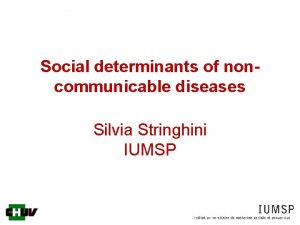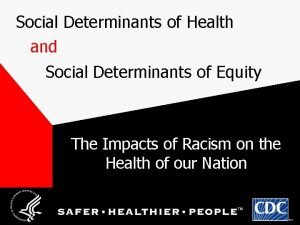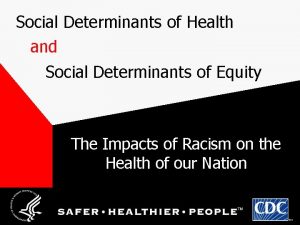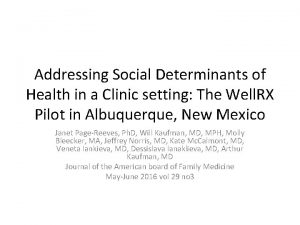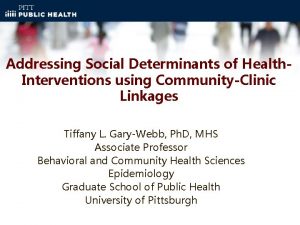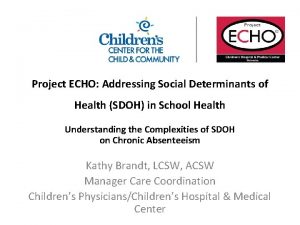Addressing the social determinants of health Silvia Stringhini

































- Slides: 33

Addressing the social determinants of health Silvia Stringhini, social epidemiologist, IUMSP

Objectives • Understand the role of social factors as determinants of NCDs • Address the social determinants of NCDs • Recognize interventions impacting on social inequalities in NCDs Outline • Social inequalities in NCDs • Underlying mechanisms, prevention strategies • The UN and the social determinants of NCDs • Take home messages

Social inequalities in NCDs

Inequalities in male life expectancy at birth between and within countries Country Male life expectancy at birth Angola 40 UK, Glasgow (Calton) 54 India 62 Lithuania 65 Mexico 72 United States 75 Cuba 76 Switzerland 79 UK, Glasgow (Lenzie N. ) 82 Sources: WHO, World Health Statistics 2008; Hanlon, Walsh & Whyte 2006; Murray et al. 2006

Social inequalities in NCDs within countries § Systematic differences in health observed along axes of socioeconomic position, gender, race/ethnicity and geography, even when health care is universally accessible § Social inequalities in CD and NCDs § Health risk accumulates over time beginning at conception social determinants of health act across the lifecourse

Cardiovascular disease mortality in the Whitehall II cohort (UK) 3. 5 § SES powerfully predicts NCDs 2. 2 § Effect of SES ~ smoking Source: Stringhini S et al. JAMA, 2010.

Cardiovascular disease mortality in Brazil (Porto Alegre) Cardiovascular deaths of people aged 45 -64 by city district Source: Bassanesi S et al. Arq Braz Cardiol, 2008. Premature death rate for CVD 2. 6 times higher in poorer districts of the city

Trend in the social patterning of NCDs risk factors. Repeated surveys in the Seychelles. § Prevalence of NCDs risk factors (exception of smoking in men) often higher among the rich in LICs and higher among the poor in MICs. § But secular shift towards the poor along the progression of the epidemiological transition. Sources: Stringhini et al IJC 2012.

Obesity prevalence in women by education in countries at different levels of development § Obesity more prevalent among more educated women in low income countries. § Less prevalent among high educated women in upper middle income countries. Sources: Monteiro CA et al. Int J Obes Relat Metab Disord, 2004.

Change in prevalence of overweight/obesity among women from 7 African countries 1992 -2005 § Prevalence of overweight/obesity higher among high vs low educated women. § But obesity decreases over time in high SES and increases in low SES. Sources: Ziraba et al BMC Public Health 2009.

Social inequalities in NCDs: underlying mechanisms

Framework for the social determinants of health (WHO CSDH) Sources: Closing the gap in a generation: Health equity through action on the social determinants of health. Final report of the Commission on the Social Determinants of Health (CSDH). Geneva: WHO; 2008.

Lifecourse SES Social inequalities in NCDs: underlying mechanisms ENVIRONMENTAL EXPOSURES PSYCHOSOCIAL EXPOSURES BEHAVIORAL EXPOSURES - Pollution - Living/working conditions - Social relationships/support - Job strain - Lifestyle factors HEALTH ACCESS TO/USE OF HEALTH CARE § Environmental, psychosocial and behavioural exposures major factors explaining the link between SES and health. § Social patterning of behavioral factors explains largest part of social differences in NCDs(40 -60%). § Increasing role of environmental exposures. § Access to/use of health care accounts for <15% of SES differences in health in US/Europe. No studies in LMICs but probably high.

Social stratification of behavioural risk factors for NCDs § TOBACCO USE: By 2030, 70% of tobacco related deaths in LMICs. In every region of the world, lower income groups more likely to use tobacco. Prevalence generally higher in men but increasing in women. § HARMFUL USE OF ALCOHOL: More prevalent among lower socioeconomic groups in LMICs and in men than women. § PHYSICAL INACTIVITY: Higher prevalence in LMICs than HICs. In HICs, lower prevalence in higher socioeconomic groups while in LMICs (especially LICs) higher prevalence in lower socioeconomic groups. § UNHEALTHY DIET: Higher quality diet associated with affluence in most countries. However, nutrition transition touches higher socioeconomic groups first in LMICs, so higher consumption of processed and refined foods and trans fats in higher income groups in LMICs, who abandon first traditional dietray patterns. . But changes over time.

Lifecourse perspective on NCDs üEarly years of life key determinants of health at older ages üEarly disadvantage has lifelong effect on health and NCDs üTwo pathways: cumulative damage over time and biological embedding of adversities during sensitive periods (ie: in utero, social determinants of epigenetic modifications) üImportance of addressing social determinants in sensitive periods such as pregnancy and adolescence

Social inequalities in NCDs: prevention strategies

Burden NCDs Social inequalities in NCDs: prevention strategies Existing social inequalities in NCDs SCENARIO 1 Whole population approach: ‘agentic’ prevention strategies Whole population approach: ‘structural’ prevention strategies SCENARIO 2 IDEAL Low SES High SES § Prevention strategies relying on individuals' capacity to respond (“agentic”) are likely to increase the health gap between SES groups disproportionally benefit high SES individuals § Structural strategies likely not only to reduce NCD burden but also have impact on social inequalities in NCDs (example: ban on public smoking affects everybody the same).

Structural prevention strategies likely to reduce social inequalities in health – acting on proximal determinants: • Fluoridation of drinking water • Clean indoor air laws • Elimination of trans fats/reduction or salt content in foods by jurisdiction • Mandatory folate fortification of cereal-grain products • Free child care – acting on distal determinants: • Redistributive policies aimed at reducing socio-economic disparities • Policies promoting public education and public health care • Policies promoting safer work places

Key enabling of action on social determinants of NCDs §High level political commitment ü Building support for action requires showing that improving social conditions can improve population health and support other development objective ü Challenging as may require action against powerful lobbies (tobacco, pharmaceutical, food and beverage companies) üAnalysis of cost of health inequities may provide powerful argument § Governance mechanism to coordinate multisectorial responses ü Coherent governmental approach ü Joint action across distinct departments §Robust structures for monitoring ü Build on Global Monitoring Framework by establishing national NCDs targets and indicators related to social determinants of health ü Useful tool: WHO Urban Health Equity Assessment and response Tool §Evaluation and accountability

Intervention strategies to reduce social inequalities in health should: § Consider the diffusion of innovations theory: differences in uptake between early adopters (likely high SES) and later adopters (likely low SES), who may require special efforts. § Assess where the proposed intervention falls on a continuum from agency to structure Strategies relying on individual agency more likely to worsen social inequalities in NCDs. § Issue of lifecourse. Important to limit the consequences of exposure to low SES in critical periods of development as they will impact health in adulthood. §Be multisectorial.

Typologies of mutilsectorial actions Sources: UNDP: Addressing the social determinants of non-communicable diseases. 2013

Expanding delivery platforms §Using settings outside the health system (school, workplaces, religius centers) to deliver conventional interventions üMonitoring of NCDs risk factors in school üFood labelling üHealth promotion and nutrition education in schools Focus on individual decision making and less on the context in which decision are made: may increase health inequalities

NCDs specific actions on social determinants §Laws, policies and programmes whose primary purpose is action on social determinants of NCDs üTobacco taxes (decrease social inequalities in tobacco use) üIncrease import duties on fizzy drinks üLaws that restrict density of fast foods üIncentives to vendors to sell fruit and vegetables in poor areas Very effective §Example: Taxes on sugary beverages or bans in alchool sachets ü 2007: Government of Nauru implements a “sugar levy”; 2002: French Polynesia introduces taxes on sugar-sweetened beverages ü 2012: Zambia bans the manufacture, sale and consumption of strong liquor sachets, popular among youths and lower socioeconomic groups decrease of number of people with alcohol intoxication

NCDs sensitive actions on social determinants §Policies and laws addressing the distribution of power and resources throughout society üImprovements in employment and working conditions üSocial protection policies üImprovements in education system üLaws for safe and healthy living environments (including regulation of pollution) Very effective §Example: Brazil Bolsa Familia’s conditional cash transfer system üCash transfers to poor families with children that resulted in improved food security, nutritional outcomes among young children and reduced school absence and child labour

Hyderabad nutrition trial (1987 -90), India Food supplementation to pregnant women in 15 poor Indian rural villages (14 villages controls) Baseline (1987 -90) ü Children born to supplemented mothers +61 g birthweight Follow-up (2003 -05) ü 14 mm taller ü Same fat mass ü Lower risk of cardiovascular disease ü Insulin resistance (HOMA): 20% lower ü Arterial stiffness: 3% lower ü Systolic blood pressure: 0. 6 mm Hg lower Sources: Kinra et al. BMJ 2008.

Water fluoridation (1993 -94), United Kingdom Water fluoridation in 7 districts vs 7 control of same SES DECAYED THEET § Decayed theet (DT) üMean 0. 87 in fluoridated district; 1. 8 in non-fluoridated district (p<0. 0001) § The intervention benefits most the most disadvantaged areas inequalities reduced DEPRIVATION Sources: Riley et al. IJE 1999. Probably same effects for other structural interventions such as trans fats/salt reduction in food

Social inequalities in NCDs: Rio Political Declaration on Social Determinants of Health (October 2011) More relevant acknowledgments: § Health inequities within and between countries are politically, socially and economically unacceptable, as well as unfair and largely avoidable § Health inequities arise from the societal conditions in which people are born, grow, live, work and age § Good health requires a universal, comprehensive, equitable, effective, responsive and accessible quality health system More relevant actions: § Work across different sectors and levels of government § Develop inclusive policies (specific attention to vulnerable groups) § Strengthen occupational health safety § Promote and strengthen universal access to social services § Build, strengthen and maintain health financing and risk pooling systems

Social inequalities in NCDs: WHO Global NCDs Monitoring Framework (March 2012) The global reporting system should give ample attention to disaggregated data for the indicators to be able to ascertain trends in inequality. Monitor core indicators for NCDs by key dimensions of equity including gender, age, and socioeconomic status. “Global monitoring framework should set targets that aim to reduce inequities and take the key social determinants into account. ”

Social inequalities in NCDs: WHO Global Action Plan for the Prevention and Control of NCDs for 2013 -2020 Promote health and equity in relation to prevention and control of NCDs. When making public health decisions, consideration should be given to cost-effectiveness and affordability, implementation capacity, feasibility, impact on equity and poverty, as well as the balance between population wide interventions and individual interventions. Policies, plans and services for the prevention and control of NCDs need to take account of health and social needs at all stages of the life course, starting with maternal health, . . . , and continuing through proper infant feeding practices, . . . , followed by promotion of a healthy working life, healthy ageing and care for people with NCDs in later life.

Social inequalities in NCDs: Action Plan for European Strategy for the Prevention and Control of NCDs A focus on equity. Specific attention to whether social determinants affect people’s opportunities to make and sustain healthy choices. A life course approach. Exposure to the risk of NCDs accumulates throughout the life course, starting with influences that occur during pregnancy and continuing through early childhood, adolescence and adulthood. Balance population-based and individual approaches. Most cases of disease are found in those at low or moderate risk, and only a minority of cases are in those at high risk. Disseminate and advocate for improved universal access to more comprehensive and equity-sensitive packages of NCD interventions.

Social inequalities in NCDs: Take home messages

Take home messages § For policies aimed at reducing social inequalities in NCDs crucial to consider that different SES groups are likely to respond differently to prevention strategies targeting the whole population prioritizing “structural” prevention strategies § Whenever possible, the fact that SES acts across the lifecourse to affect NCDs risk should be considered attention to exposures in early life which are not only relevant for communicable diseases but also for NCDs (also emphasized in the global action plan for the prevention and control of NCDs 2013 -2020) §Critical to put health equity in all policies. § Health equity issues are more and increasingly present in the global agenda of international organisations (UN, WHO) good window of opportunities in LMICs to implement policies developed to prevent and control NCDs, with specific attention to their social distribution

Thanks for your attention Source: National strategy to reduce social inequalities in health, The Norwegian Institute of Public Health (2006 -2007)
 Gianluca stringhini
Gianluca stringhini Flat addressing vs hierarchical addressing
Flat addressing vs hierarchical addressing What are the 6 main social determinants of health?
What are the 6 main social determinants of health? Physical environment determinants of health
Physical environment determinants of health Social determinants of personality
Social determinants of personality Social determinants of aggression
Social determinants of aggression Health and social care component 3 health and wellbeing
Health and social care component 3 health and wellbeing Social thinking and social influence
Social thinking and social influence Social thinking social influence social relations
Social thinking social influence social relations Hình ảnh bộ gõ cơ thể búng tay
Hình ảnh bộ gõ cơ thể búng tay Slidetodoc
Slidetodoc Bổ thể
Bổ thể Tỉ lệ cơ thể trẻ em
Tỉ lệ cơ thể trẻ em Voi kéo gỗ như thế nào
Voi kéo gỗ như thế nào Tư thế worm breton
Tư thế worm breton Alleluia hat len nguoi oi
Alleluia hat len nguoi oi Môn thể thao bắt đầu bằng từ đua
Môn thể thao bắt đầu bằng từ đua Thế nào là hệ số cao nhất
Thế nào là hệ số cao nhất Các châu lục và đại dương trên thế giới
Các châu lục và đại dương trên thế giới Công của trọng lực
Công của trọng lực Trời xanh đây là của chúng ta thể thơ
Trời xanh đây là của chúng ta thể thơ Cách giải mật thư tọa độ
Cách giải mật thư tọa độ 101012 bằng
101012 bằng Phản ứng thế ankan
Phản ứng thế ankan Các châu lục và đại dương trên thế giới
Các châu lục và đại dương trên thế giới Thơ thất ngôn tứ tuyệt đường luật
Thơ thất ngôn tứ tuyệt đường luật Quá trình desamine hóa có thể tạo ra
Quá trình desamine hóa có thể tạo ra Một số thể thơ truyền thống
Một số thể thơ truyền thống Cái miệng bé xinh thế chỉ nói điều hay thôi
Cái miệng bé xinh thế chỉ nói điều hay thôi Vẽ hình chiếu vuông góc của vật thể sau
Vẽ hình chiếu vuông góc của vật thể sau Biện pháp chống mỏi cơ
Biện pháp chống mỏi cơ đặc điểm cơ thể của người tối cổ
đặc điểm cơ thể của người tối cổ Ví dụ giọng cùng tên
Ví dụ giọng cùng tên Vẽ hình chiếu đứng bằng cạnh của vật thể
Vẽ hình chiếu đứng bằng cạnh của vật thể


































